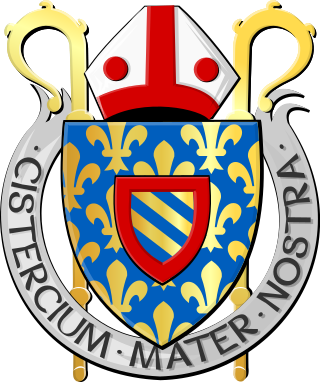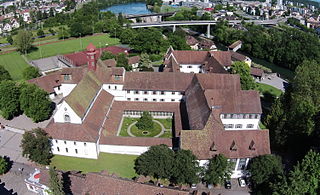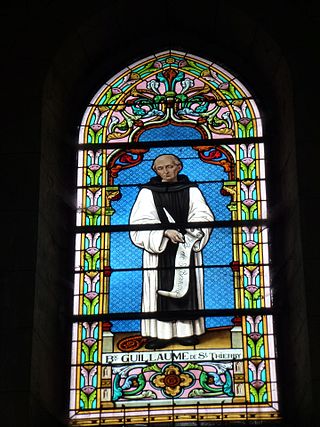Stephen of Sawley (died 6 September 1252), also known as Stephen of Easton, was a Cistercian monk, born in Eston, Yorkshire in the late twelfth century.
He had economic ties with the Fountains Abbey and when he decided to enter the monastic life, he withdrew to Fountains and was moulded there in the Cistercian way of life. Stephen held the prestigious office of cellarer at Fountains in around 1215, and in 1223 was chosen by the monks of Sawley Abbey, a granddaughter of Fountains (the abbey having been founded in 1147 by Newminster Abbey in Northumberland, itself a foundation of Fountains), to preside as abbot over their community. He held this post for ten years and during this time is known to have attended the annual General Chapter at Cîteaux in 1226 and 1230.
In 1234 Stephen left Sawley to take up the abbacy at its mother-house, Newminster, in Northumberland, and remained here until 1247 when he was elected to the abbacy of his former community, Fountains. Stephen presided as abbot of Fountains until his death in September 1252. He died at Fountains’ daughter-house, Vaudey Abbey, in Lincolnshire, where he had been conducting an annual visitation of the abbey. He was buried in Vaudey's chapter-house in front of the abbot's chair – a privileged and prominent position.

Bernard of Clairvaux, O.Cist., venerated as Saint Bernard, was an abbot, mystic, co-founder of the Knights Templar, and a major leader in the reform of the Benedictines through the nascent Cistercian Order.

Cîteaux Abbey is a Catholic abbey located in Saint-Nicolas-lès-Cîteaux, south of Dijon, France. It is notable for being the original house of the Order of Cistercians. Today, it belongs to the Trappists.

The Cistercians, officially the Order of Cistercians, are a Catholic religious order of monks and nuns that branched off from the Benedictines and follow the Rule of Saint Benedict, as well as the contributions of the highly-influential Bernard of Clairvaux, known as the Latin Rule. They are also known as Bernardines, after Saint Bernard himself, or as White Monks, in reference to the colour of the "cuculla" or cowl worn by the Cistercians over their habits, as opposed to the black cowl worn by Benedictines.

Fountains Abbey is one of the largest and best preserved ruined Cistercian monasteries in England. It is located approximately 3 miles (5 km) south-west of Ripon in North Yorkshire, near to the village of Aldfield. Founded in 1132, the abbey operated for 407 years, becoming one of the wealthiest monasteries in England until its dissolution, by order of Henry VIII, in 1539.

The Trappists, officially known as the Order of Cistercians of the Strict Observance and originally named the Order of Reformed Cistercians of Our Lady of La Trappe, are a Catholic religious order of cloistered monastics that branched off from the Cistercians. They follow the Rule of Saint Benedict and have communities of both monks and nuns that are known as Trappists and Trappistines, respectively. They are named after La Trappe Abbey, the monastery from which the movement and religious order originated. The movement first began with the reforms that Abbot Armand Jean le Bouthillier de Rancé introduced in 1664, later leading to the creation of Trappist congregations, and eventually the formal constitution as a separate religious order in 1892.
Vaudey Abbey, also known as Vandy Abbey or Vandey Abbey, was an English Cistercian abbey. It was founded in 1147 by William, Count of Aumale, Earl of York. Its site is within the Grimsthorpe Castle park, in Lincolnshire, 3.7 miles (6 km) northwest of Bourne on the A151, but there are no remains of the Abbey aside from earthworks.
Henry Murdac was abbot of Fountains Abbey and Archbishop of York in medieval England.

Newminster Abbey was a Cistercian abbey in Northumberland in the north of England. The site is protected by Grade II listed building and Scheduled Ancient Monument status.

Sawley Abbey was an abbey of Cistercian monks in the village of Sawley, Lancashire, in England. Created as a daughter-house of Newminster Abbey, it existed from 1149 until its dissolution in 1536, during the reign of King Henry VIII.

Shasta Abbey, located on sixteen forested acres near Mount Shasta in northern California, United States is a training monastery for Buddhist monks and a place of practice for lay Buddhists and interested visitors. It was established in 1970 by Reverend Master P.T.N.H. Jiyu-Kennett, who was Abbess and spiritual director until her death in 1996.

Wettingen Abbey was a Cistercian monastery in Wettingen in the Swiss canton of Aargau. It was founded in 1227 and dissolved during the secularisation of 1841, but re-founded at Mehrerau in Austria in 1854. The buildings are listed as a heritage site of national significance.

The Abbot and then Commendator of Melrose was the head of the monastic community of Melrose Abbey, in Melrose in the Borders region of Scotland. The abbots of the earlier Northumbrian foundation from Lindisfarne are not included here. The second abbey was founded in 1136 on the patronage of David I, King of Scots, by Cistercian monks from Rievaulx Abbey, Yorkshire. Control of the abbey was secularized in the 16th century and after the accession of James Stewart, the abbey was held by commendators. The last commendator, James Douglas of Lochleven, resigned the abbacy to William Douglas, 6th Earl of Morton in December 1606, and the abbey itself to the king in 1608. The abbey was then erected into a secular lordship for viscount Haddington, John Ramsay, who in 1609 was created "Lord Melrose". Lochleven however resumed the title of commendator in 1613 until his death in 1620.

Robert of Newminster was a priest, abbot, and a saint of the Catholic Church. He was born in Gargrave in Yorkshire, England. He was one of the monks who founded Fountains Abbey and is named from the abbey he founded in Morpeth, Northumberland.

Whalley Abbey is a former Cistercian abbey in Whalley, Lancashire, England. After the dissolution of the monasteries, the abbey was largely demolished and a country house was built on the site. In the 20th century the house was modified and it is now the Retreat and Conference House of the Diocese of Blackburn of the Church of England. The ruins of the abbey are recorded in the National Heritage List for England as a designated Grade I listed building, and are a Scheduled Ancient Monument.

William of Saint-Thierry, O. Cist was a twelfth-century Benedictine, theologian and mystic from Liège who became abbot of Saint-Thierry in France, and later joined the Cistercian Order.

The Prior, then Abbot and then Commendator of Dunfermline was the head of the Benedictine monastic community of Dunfermline Abbey, Fife, Scotland. The abbey itself was founded in 1128 by King David I of Scotland, but was of earlier origin. King Máel Coluim mac Donnchada had founded a church there with the help of Benedictines from Canterbury. Monks had been sent there in the reign of Étgar mac Maíl Choluim and Anselm had sent a letter requesting that Étgar's brother and successor King Alaxandair mac Maíl Coluim protect these monks. By 1120, when Alaxandair sent a delegation to Canterbury to secure Eadmer for the bishopric of St Andrews, there is a Prior of the Dunfermline monks by the name of Peter leading the delegation. Control of the abbey was secularized in the 16th century and after the accession of James Stewart in 1500, the abbey was held by commendators. In the second half of the 16th century, the abbey's lands were being carved up into lordships and it was finally annexed to the crown in July, 1593.
Richard was an English Benedictine and Cistercian, the first abbot of Fountains.
Christian Feurstein, was an Austrian Roman Catholic priest and Cistercian monk at Heiligenkreuz Abbey, Stiepel Priory, Rein Abbey in Gratwein-Straßengel, Styria. He served as abbot of the Rein Abbey from 2010 to 2015.

The Harding Bible is a 12th-century illuminated Latin Bible created in Cîteaux Abbey during the abbacy of Stephen Harding, dated 1109. It belongs to a corpus of manuscripts illuminated in the Cîteaux scriptorium in the 12th century, now mostly in the public library of the city of Dijon. It is considered a masterpiece of Cistercian book illumination.














